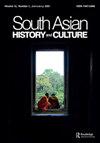Redrawing boundaries of belonging among Indian Himalayan Buddhists
IF 0.3
0 ASIAN STUDIES
引用次数: 0
Abstract
ABSTRACT As the world speculates about a post-Dalai Lama scenario, what is the response among India’s borderland Buddhists? In this paper, I show that there is a growing need among Tibetan Buddhist people of the Indian Himalayan borderlands to forge a cultural unity that is Buddhist but removed from Tibet. With the decline of Tibet as a spiritual and cultural centre for Tibetan Buddhism, Himalayan Buddhist communities of India are strategically cohering around new identities and spaces that are firmly rooted in India. Given an impending future, when Buddhists around the world, and particularly in Asia, will no longer be able to depend on the figure of the Fourteenth Dalai Lama for guidance, there are concerted efforts underfoot to unite the Himalayan Buddhists of Ladakh, Sikkim, Arunachal Pradesh and other border regions of India under a common platform. In this regard, research organizations, cultural associations, and educational institutions are assuming a key role. While many scholarly works have studied the role of associations and institutional spaces in the formation of a transnational identity for Indian Buddhists, this paper focuses on the transregional networks forged through cultural and educational institutions in the Himalayan border regions of India, focusing on the Delhi-based Himalayan Buddhist Cultural Association (HBCA) and other new organizations working for an Indian Himalayan Buddhist unity. I draw on my ethnographic work in Monyul, a Tibetan Buddhist cultural region in Arunachal Pradesh, Northeast India, to show how the Buddhist Monpas of Monyul are drawn into the pan-regional networks of Indian Himalayan Buddhism.重新划定喜马拉雅印度佛教徒的归属界限
摘要当全世界都在猜测后达赖喇嘛时代的情景时,印度边境佛教徒的反应是什么?在这篇论文中,我表明,印度喜马拉雅边境的藏传佛教人民越来越需要建立一个佛教但远离西藏的文化团结。随着西藏作为藏传佛教精神和文化中心的衰落,印度喜马拉雅佛教社区正围绕着牢固植根于印度的新身份和空间进行战略整合。鉴于未来即将到来,当世界各地,尤其是亚洲的佛教徒将无法再依赖第十四世达赖喇嘛的形象来指导时,人们正在共同努力,将拉达克、锡金、印控"阿鲁纳恰尔邦"和印度其他边境地区的喜马拉雅佛教徒团结在一个共同的平台下。在这方面,研究组织、文化协会和教育机构正在发挥关键作用。虽然许多学术著作都研究了协会和制度空间在印度佛教徒跨国身份形成中的作用,但本文关注的是通过印度喜马拉雅边境地区的文化和教育机构建立的跨地区网络,专注于总部位于德里的喜马拉雅佛教文化协会(HBCA)和其他致力于印度-喜马拉雅佛教团结的新组织。我利用我在印度东北部印控"阿鲁纳恰尔邦"藏传佛教文化区蒙育的民族志工作,展示了蒙育的佛教蒙巴人是如何被引入印度喜马拉雅佛教的泛区域网络的。
本文章由计算机程序翻译,如有差异,请以英文原文为准。
求助全文
约1分钟内获得全文
求助全文

 求助内容:
求助内容: 应助结果提醒方式:
应助结果提醒方式:


